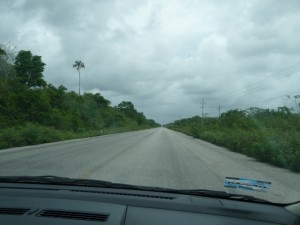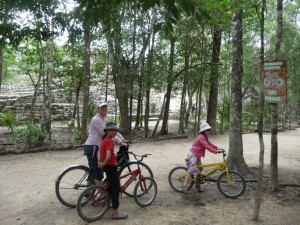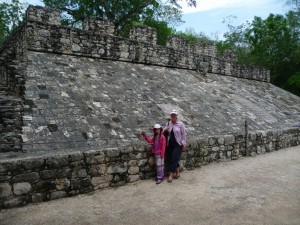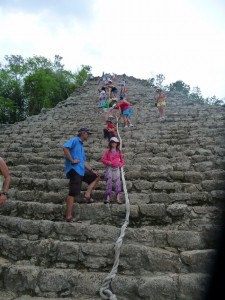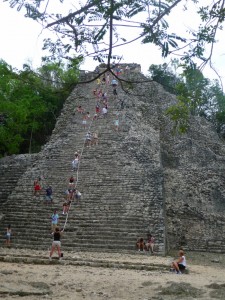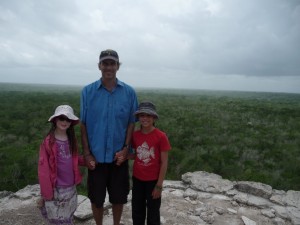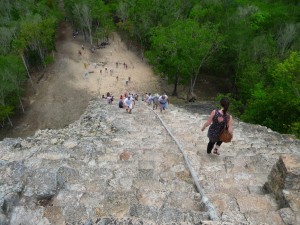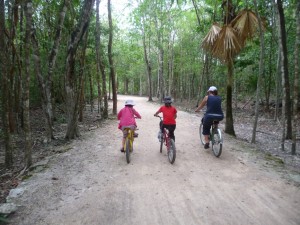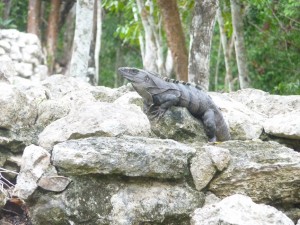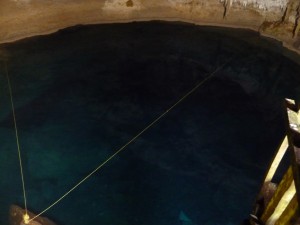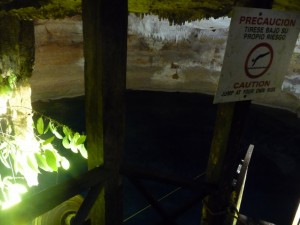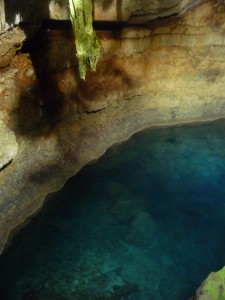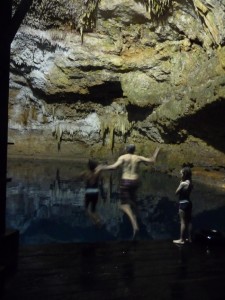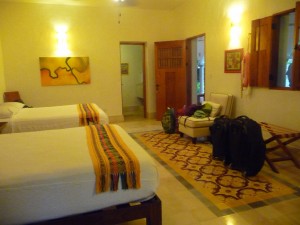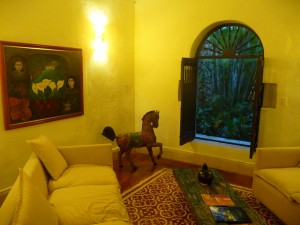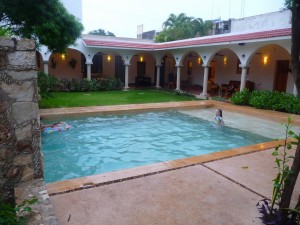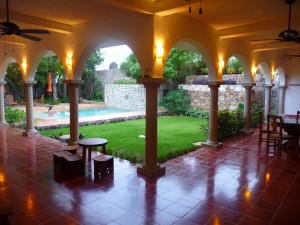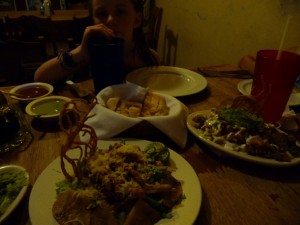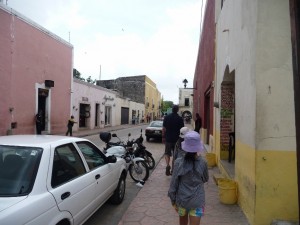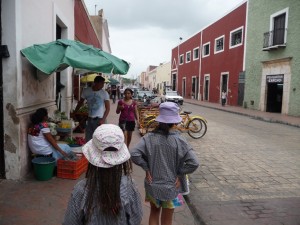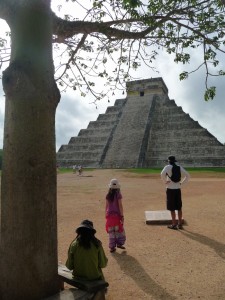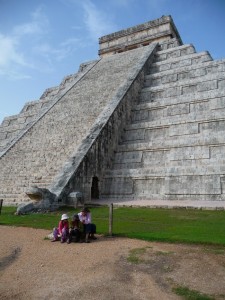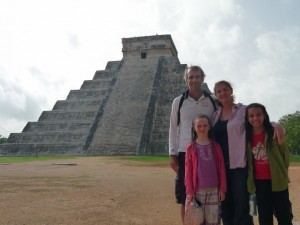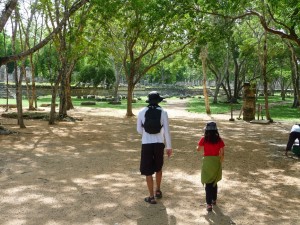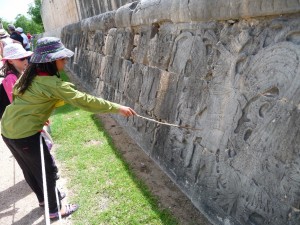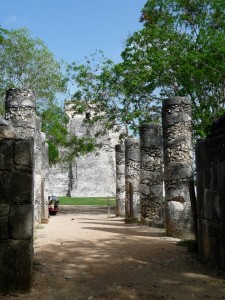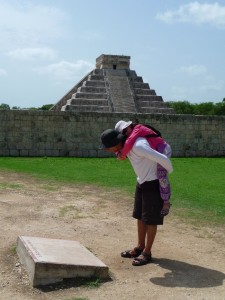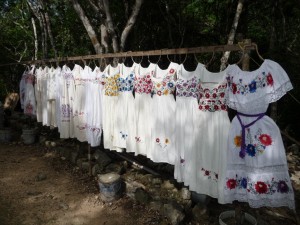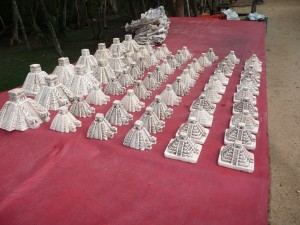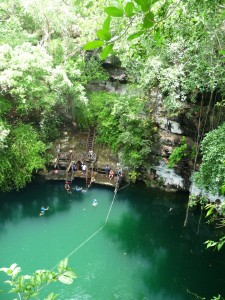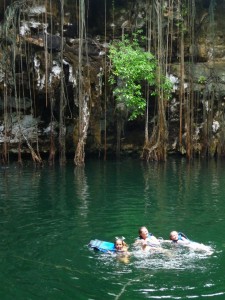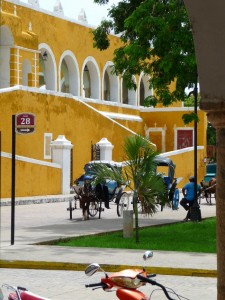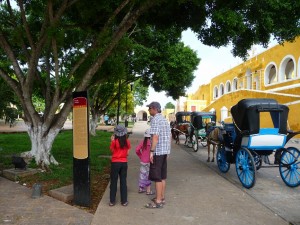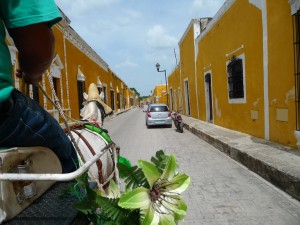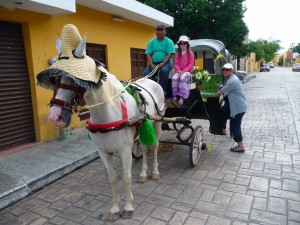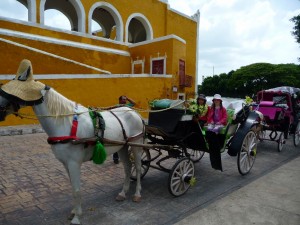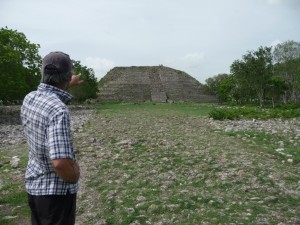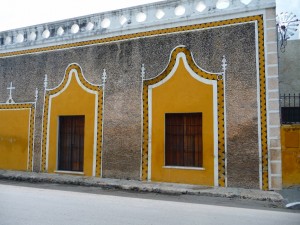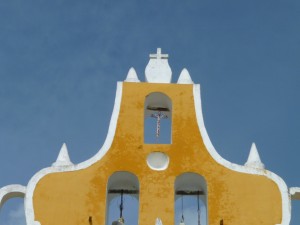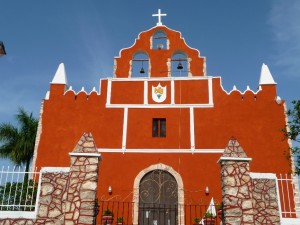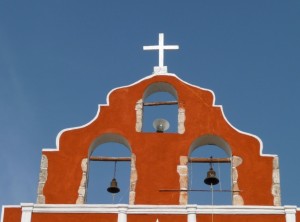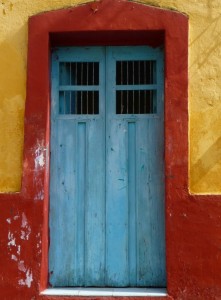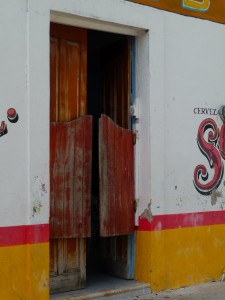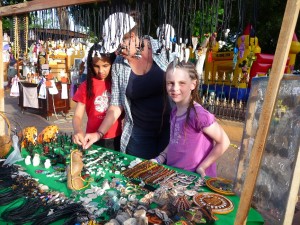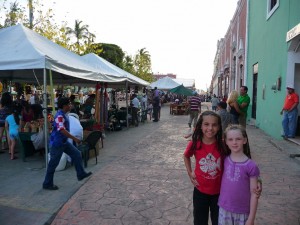More Mayan ruins and amazing cenotes – and the charming inland town of Valladolid
Posted by asuasu69 on Jun 15, 2013 in Mexico | 0 comments
by David.
We bid a sad farewell to the gorgeous coastal area of Tulum and set off mid-morning, strictly adhering to the posted speed limits so as not to give the local constabulary any reason to pull us over. Taxis and buses overtook and sped past on the open highway, however everyone must slow down when approaching villages as have speed humps (called ‘Topes’ in Spanish) of various sizes to keep vehicular speeds down. The Mexican roads and highways are in very good condition and directions are (mostly) well signposted, making it easy for us to find our way around, which was just as well as we had no maps nor GPS so were driving quite ‘blind’.
Just after lunch, we arrive at the Coba ruins, one of the last places in Mexico where tourists are still allowed to climb the Mayan pyramid, which is also one of the largest. After a sandwich for lunch from our provisions in the hire car, we enter the park and hire bicycles to explore the ruins. The paths are shaded and area quite spread out, so the bikes are definitely the way to go, even if just to appease the girls who are happier when doing an activity rather than just walking and looking at more ruins.
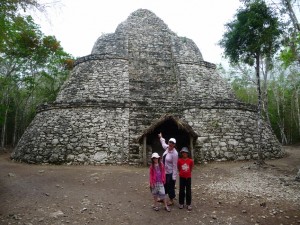
After a stop at one of the city ball-courts, we find ourselves at the main pyramid. With Sally feeling very pensive about climbing the structure, the girls and I begin the ascent up the uneven limestone steps. A thick rope lies up the centre of the staircase to assist both ascending and descending climbers.
It doesn’t take long for us to reach the top, although a little breathless. The view from the top over the flat countryside is impressive. After catching our breaths and taking in the sights, we begin the decent which is nearly always more dangerous. Many of our fellow visitors descend on their bottoms as I think everyone is aware that if you trip or fall on the way down, you won’t stop until you hit the ground.
Back on the bikes for some more exploring and it’s time to make our way to the next stop; a nearby cenote to cool off. There is only one other car in the car park, and we head to the change rooms before making our way down the spiral staircase into the completely enclosed cenote. With no natural light finding its way down, several large floodlights provide the illumination, and soon we are the only ones making use of the cool waters. The spiral staircase also has two platforms for some of the only cave cliff diving in the world: the first platform is at about 5 metres and the second at about 10 metres. In my younger days, I probably would have given the five metre jump a go, but the dim light and smooth clear water makes it almost impossible to judge where the water’s surface is.
After about an hour, we continue our drive west and arrive at our B&B in the late afternoon in Valladolid. Recently re-opened after renovations, the Pousada San Juan is a beautiful Spanish colonial style hacienda with four guest rooms. Our large room has double king beds, air conditioning, private bathroom and wi-fi. The large house is stunning and the owners have done wonderful job with their reno.
A high wall separates the private garden and swimming pool from the busy street outside, and a covered veranda lies around two of the other sides of the pool and leads to three of the guest rooms. Sonja is our host and cook, and she speaks absolutely no English which tests Sally’s and my Spanish over the next few days. Sonja makes fresh banana cake every other day during our stay and prepares a wonderful breakfast each morning.
The air conditioning is a welcome relief after the hot days at the seaside with fans (no mains power in that area of Tulum means services are limited), and the girls love having a pool right outside our bedroom door. Upon Sonjas recommendation, we head to small local café just down the street for dinner. Sally and I enjoy a sangria before a very nice dinner. We check the café on Tripadvisor after returning to our room and discover it is rated the number two place in the town to eat. A good choice.
We spend a day just walking around the town and down some of the streets radiating off the central park, eating ice creams and even doing a bit of *shock /horror * shopping – as anyone who knows us, we very rarely buy things as we don’t want to have to carry it, have nowhere for it to go when we get back home and prefer to spend our money on experiences not ‘things’.
No visit to this part of Mexico would be complete without a visit to Chichen Itza: perhaps the most well known of all the Mayan cities on the Yucatan Peninsula and home to the famous and much photographed Kukulkan Pyramid.
Impressive Chichen Itza is only about a 45 minute drive from our hotel, so we plan an early departure and visit before the tourist buses and heat arrives by mid-morning. We are among the first cars in the car park ahead of the 8.30am opening time and make the most of low visitor numbers to get some photos by the pyramid.
From the pyramid, a ceremonial causeway leads 300 metres to the Sacred Cenote, a large, open, circular cenote containing fairly uninviting green water. Here the Maya would toss their valuables into the water to gain favour with the gods that lived within. The water is only about 6 metres deep, and when diving equipment became available in the early 20th century an American explored its depths removing many valuable artefacts made of gold and jade. Animal bones and those of at least 20 humans (mostly young males aged 14-20) were also discovered.
The Maya did not fear death and believed that this life was just a means to reach the next. The present day Mexicans also have no real fear death and have a day set aside in November to honour their ancestors. Perhaps this is why it was easy for them to embrace Christianity, when it came with the Spanish, which teaches the existence of heaven where we will all meet again in the afterlife. Hmmm.
We explored most of the rest of the city including the round building called the Observatory which was used for astrology, and also the largest ball court at any Mayan city. All around us locals were setting up their stalls and placing out their wares for the day – truly a very commercial venture and really such a shame that it should be allowed in and around the actual ruins.
By this stage – around 10.45am, the heat was soaring as were the crowd numbers, so we swam against the tide of humans streaming through the front gate and headed for our car. With every visit to ruins comes a swim, so we made our way to nearby cenote to cool off. Another open air cenote, the water was not as clear as we prefer, and being so close to a major tourist attraction also makes it quite busy, and the first that we had come across that you had to wear life-jackets. Still, it served its purpose and we were soon ready to hit the road again.
We had read that a town about 45kms away called Izamal was worth a visit so we headed there for a late lunch. Also nicknamed ‘The Yellow City’, all the buildings close to the town centre have been painted a rich yellow colour and the town is home to the largest convent and church courtyard outside of Rome.
When Pope John Paul II held mass here in 1993, a reported 17,000 people attended. We found a café off the main square for lunch and then took a horse and buggy combinations on a private 30 minute tour of the city. Our horses name was Hercules, although that hat seemed to detract from the tough-man image usually associated with the name.
Once again, our guide spoke no English but we managed to get the gist of most of what he was telling us. We were very surprised to turn a corner not far from the city centre and find one of the largest Mayan pyramids on the whole peninsula, Kinich Kakmo. The base measures an amazing 180 x 200 metres and, although not complete in the sense of having a point, a smaller pyramid has been built on top which measures 34 metres in height. In this next photograph, I can be seen standing in an open area with trees pointing at another pyramid. This is actually the smaller pyramid as I am already standing on the larger base pyramid. This was all built by hand and the sheer quantity of fill required is mind blowing.
After Izamal we make our way back to Valladolid driving through the gorgeous little colonial towns with their colourful facades stopping so Sally can take photos of the front facades as well as more of her favourite ‘subject’ – doors.
We made it back to Valladolid in time to catch the last of the Sunday markets in the main square where Sally picks up a pair of hand-made leather sandles, and Immi gets a miniature hammock for her beloved Scruffy and Phoebe picks out a leather necklace with a carved ‘owl’ – her animal choice at the moment.
Later that afternoon, while sitting by the pool while the girls swim, the son of one of the B&B owners stops by on his way home to another city. He speaks perfect English and shows us pictures of himself as a boy in one of the gorgeous coffee-table picture book of Cenotes we have been admiring through as a result of us saying how blown away by these natural phenomena. Alejandro tells us of Agua Dulce (Sweet Water) cenote which is on a back road leading from Ek Balam to Tulum – therefore confirming our decision to see this final ruin and our last cenote before making our way back to the coast and our final stay in Mexico in Playa del Carmen. Again as we have no maps or GPS we try google maps on the laptop and he zooms in on the secondary roads around EK Balam and vaguely points out approximately where he thinks it is. We will try our best to find it!


